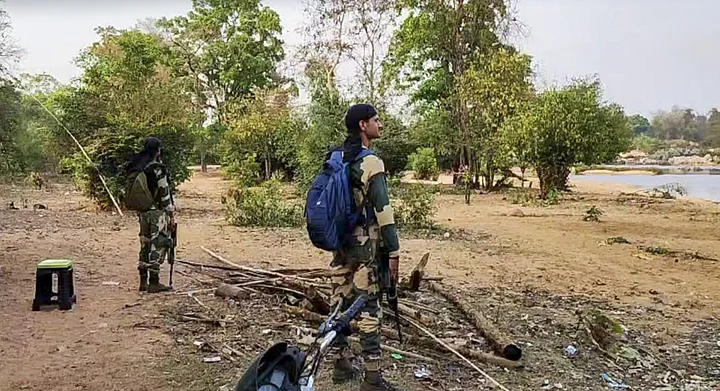Over 29 Maoists were killed in an encounter with security forces in Kanker district in Chhattisgarh's Bastar division on Tuesday, 16 April.
With just three days to go for the 2024 Lok Sabha elections to commence, this is one of the biggest operations (in terms of casualties on the Maoist side) that has been carried out in recent history.
However, when security forces moved into the camp in Kanker as part of a search operation, they didn't know it would become one of the biggest anti-Maoist operations in the history of Chhattisgarh's fight against Maoists.
After the operation, the Chhattisgarh Police confirmed the deaths of 29 Maoists and further said that the figure could increase as a combing operation was also underway.
So, how did one of the biggest anti-Maoist operations in the state unfold?.
Better Informer System, Precise Execution: Police
A source in Chhattisgarh Police who was a part of Tuesday's operation said that the planning had been in the works for nearly two months with informers who had been spying on Maoist cadre continuously providing inputs of their movements.
"We had very strong information about the movement of top Maoist leaders in the Hapotala forests of Binagunda and Korenar villages falling under Chhotebethiya police station limits in Kanker. We had been planning to intercept their movement at that spot, so around 200 personnel, including commandos from the Border Security Forces and District Reserve Guards moved for the operation as a joint team," the source said.
According to police sources, around 25 commandos of the Border Security Force (BSF), including team leader Ramesh Chandra Chaudhary, left the camp at around 5am on Tuesday morning and took positions surrounding the Maoist camp from the eastern side by pushing against the high grounds that they (the Maoists) were occupying.
"They never expected the commandos to attack from this side because it was the highest peak in the area, and the top rung of the Maoists typically takes the high ground for increased security,” the source said.
At around half past one in the afternoon, the security forces encountered the first attack from the Maoists and responded with retaliatory fire.
“Our unexpected maneuver surprised them, and although they hit our team leader with the first bullet, our jawans inflicted heavy casualties in the Maoist camp in the retaliatory fire," another source said.
Another source in Chhattisgarh Police said that a District Reserve Guard (DRG) personnel who hails from Kanker has been pivotal in fighting the Maoists in the district.
“One of our DRG personnel, I can't name him due to security reasons, has been key to major success against the Maoists in Kanker. He knows the area well and has helped build a good informers network. He has successfully participated in many anti-Maoist operations. One of the key ideas behind the formation of the DRG was to ensure that the local youth who know the area in and out could join the forces and their knowledge could be utilised in countering the Maoists' movements as well as their attacks.”Sources in the Chhattisgarh Police said
On Tuesday, police confirmed that top Maoist leaders like DVC commander Shankar Rao, carrying a bounty of Rs 25 lakh, DVC members Lalita and Madhvi were among the Maoists killed on Tuesday.
Tuesday's operation is being considered as a major blow for the Maoists as those who were killed belonged to the North Bastar divisional committee, and the number of casualties is said to hamper their activities in the Kanker district.
"We have increased the intensity of the anti Maoist operations in Bastar. Ever since the government changed in the state the anti Maoist operations have increased and we have been able to inflict major blows to the other side. We have improved on our input and information collection systems and our plannings have been very precise and that's why we have seen successful operations being carried out without any major setbacks for the forces," a senior police officer said on the condition of anonymity.
Rise in Anti-Maoist Operations Since January 2024
The security forces, in separate encounters, have killed around 80 Maoists so far in 2024. This is nearly four times more than the figure for 2023 which saw a total of 22 Maoists killed by security forces in the state.
On 2 April, over 13 Maoists were killed while two jawans sustained injuries in the encounter. Later that week, on Saturday, 6 April, three suspected Maoists were killed in another encounter.
Four days before this operation, on 27 March, security forces killed four Maoists in the Basaguda area of Bijapur district.
Wishing not to be named, a senior journalist based out of Bastar said that there have been a lot of encounters this year but not all of them were a "100 percent unquestionable."
“The security forces have improved their operations and are getting successful but the operations are not 100 percent unquestionable. In the last three major operations, the villagers have refuted the claims of security forces that all those killed were Maoists," they said.
"In the recent encounter where 13 Maoists were killed, villagers have claimed that around half of them were ordinary villagers with families and kids. The truth is yet to be ascertained but one thing is for sure that the state is now amplifying its anti-Maoist operations and this will have its impact not only on the upcoming Lok Sabha Elections but also on the overall presence of the Maoists in Bastar," they added.
(With inputs from Vishnukant Tiwari.)
(At The Quint, we question everything. Play an active role in shaping our journalism by becoming a member today.)
